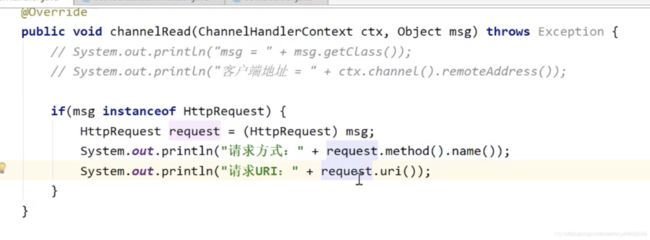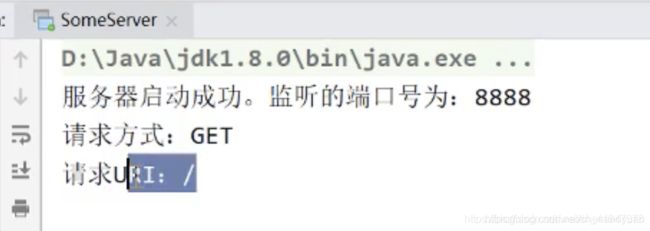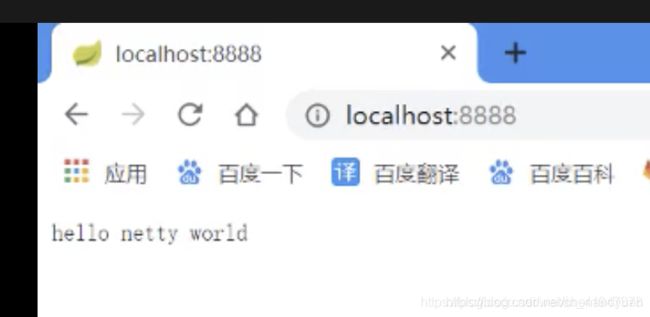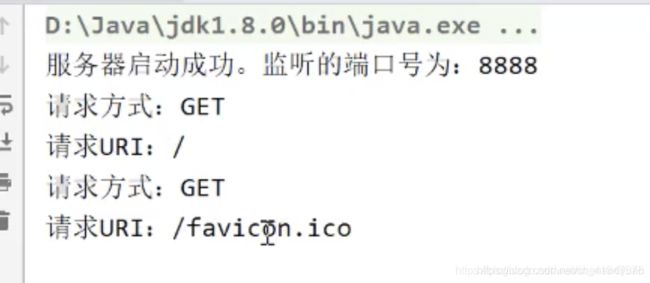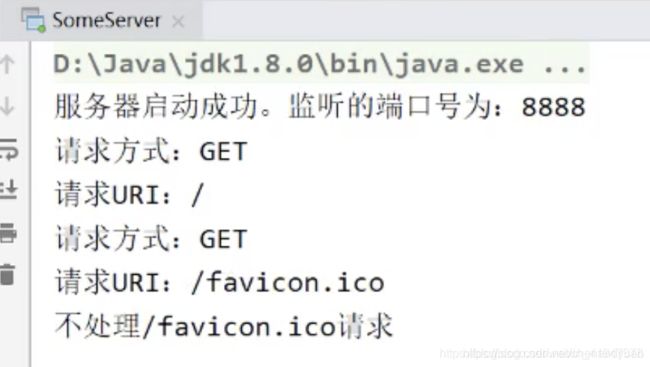Netty概述
1. Netty 概述
1.1 Netty 简介
Netty 是一个异步事件驱动的网络应用程序框架,用于快速开发可维护的高性能服务器和客户端。
Netty 是一个 NIO 客户机-服务器框架,它支持快速、简单地开发网络应用程序,如服务器和客户机。它大大简化了网络编程,如 TCP 和 UDP 套接字服务器。
“快速和简单”并不意味着生成的应用程序将受到可维护性或性能问题的影响。Netty经过精心设计,并积累了许多协议(如 ftp、smtp、http)的实施经验,以及各种二进制和基于文本的遗留协议。因此,Netty 成功地找到了一种方法,在不妥协的情况下实现了易于开发、性能、稳定性和灵活性。
1.2 谁在使用 Netty
Dubbo、zk、RocketMQ、ElasticSearch、Spring5(对 HTTP 协议的实现)、GRpc、Spark 等大型开源项目都在使用 Netty 作为底层通讯框架。
1.3 Netty 中的核心概念
(1) Channel
管道,其是对 Socket 的封装,其包含了一组 API,大大简化了直接与 Socket 进行操作的复杂性。
(2) EventLoopGroup
EventLoopGroup 是一个 EventLoop 池,包含很多的 EventLoop。 Netty 为每个 Channel分配了一个 EventLoop,用于处理用户连接请求、对用户请求的处理等所有事件。EventLoop本身只是一个线程驱动,在其生命周期内只会绑定一个线程,让该线程处理一个 Channel 的所有 IO 事件。 一个 Channel一旦与一个 EventLoop 相绑定,那么在 Channel 的整个生命周期内是不能改变的。一个 EventLoop 可以与多个 Channel 绑定。即 Channel 与 EventLoop 的关系是 n:1,而 EventLoop 与线程的关系是1:1。(一个线程可以处理多个Channel)
(3) ServerBootStrap启动类,
用于配置整个 Netty 代码,将各个组件关联起来。服务端使用的是 ServerBootStrap,而客户端使用的是则
BootStrap。
(4) ChannelHandler 与 ChannelPipeline
ChannelHandler 是对 Channel中数据的处理器,这些处理器可以是系统本身定义好的编解码器,也可以是用户自定义的。这些处理器会被统一添加到一个 ChannelPipeline 的对象中,然后按照添加的顺序对 Channel 中的数据进行依次处理。
(5) ChannelFuture
Netty 中所有的 I/O 操作都是异步的,即操作不会立即得到返回结果,所以 Netty 中定义了一个 ChannelFuture 对象作为这个异步操作的“代言人”,表示异步操作本身。如果想获取到该异步操作的返回值,可以通过该异步操作对象的 addListener()方法为该异步操作添加监听器,为其注册回调:当结果出来后马上调用执行。 Netty 的异步编程模型都是建立在 Future 与回调概念之上的。
1.4 Netty 执行流程
2. Demo1:使用Netty响应Http请求
通过该程序达到的目的是,对 Netty 编程的基本结构及流程有所了解。
该程序是通过 Netty 实现 HTTP 请求的处理,即接收 HTTP 请求,返回 HTTP 响应。
2.1 创建工程 01-primary
创建一个普通的 Maven 的 Java 工程:01-primary
2.2 导入依赖
仅导入一个 netty-all 依赖即可。
<dependencies>
<!-- netty-all 依赖 -->
<dependency>
<groupId>io.netty</groupId>
<artifactId>netty-all</artifactId>
<version>4.1.36.Final</version>
</dependency>
<!--lombok 依赖-->
<dependency>
<groupId>org.projectlombok</groupId>
<artifactId>lombok</artifactId>
<version>1.18.6</version>
<scope>provided</scope>
</dependency>
</dependencies>
2.3 定义服务器启动类
该服务器就是用于创建并初始化服务器启动对象 ServerBootStrap。
// 服务器启动类
public class SomeServer {
public static void main(String[] args) throws InterruptedException {
// 用于处理客户端连接请求,将请求发送给childGroup中的eventLoop
EventLoopGroup parentGroup = new NioEventLoopGroup();
// 用于处理客户端请求
EventLoopGroup childGroup = new NioEventLoopGroup();
try {
// 用户启动ServerChannel
ServerBootstrap bootstrap = new ServerBootstrap();
bootstrap.group(parentGroup, childGroup) // 指定eventLoopGroup
.channel(NioServerSocketChannel.class) // 指定使用NIO进行通信
.childHandler(new SomeChannelInitializer()); // 指定childGroup中的eventLoop所绑定的线程所要处理的处理器
// 指定当前服务器所监听的端口号
// bind()方法的执行是异步的
// sync()方法会使bind()操作与后续的代码的执行由异步变为了同步
ChannelFuture future = bootstrap.bind(8888).sync();
System.out.println("服务器启动成功。监听的端口号为:8888");
// 关闭Channel
// closeFuture()的执行是异步的。
// 当Channel调用了close()方法并关闭成功后才会触发closeFuture()方法的执行
future.channel().closeFuture().sync();
} finally {
// 优雅关闭
parentGroup.shutdownGracefully();
childGroup.shutdownGracefully();
}
}
}
注意点:
ServerBootstrap.handler指定的处理器是让parentGroup里面的线程绑定用的,childHandler指定的处理器是让childGroup里面的线程绑定用的(先简单理解,以后源码分析会探究)
并不是只有NIO,还可以用Oio(Oio已经过时了),但是EventLoopGroup和Channel通道类型要换成io.netty.channel.oio.OioEventLoopGroup和io.netty.channel.socket.oio.OioServerSocketChannel,一般EventLoopGroup和Channel通道类型要配对使用
NioEventLoopGroup的实现使用了Nio的Selector(事件分发器)和Channel(以后源码分析会探究)bootstrap.bind方法():该方法会创建一个Channel,并绑定一个端口,且该方法是异步的,会先返回一个异步操作结果对象
future.channel().clostFuture():该方法并不是一个关闭方法!而是返回了一个通道关闭操作的异步结果对象,当通道关闭的时候这个对象会被通知,并且这个方法返回的总是同一个实例即当其他线程调用这个channel的close()方法后,我们可以通过这个异步操作结果对象获得关闭操作的结果等信息
ChannelFuture:只要一个方法的返回值是它,说明这个方法的执行就是异步的`
/**
* The result of an asynchronous {@link Channel} I/O operation.
* 异步{@link Channel} I/O操作的结果。
*
* All I/O operations in Netty are asynchronous. It means any I/O calls will
* return immediately with no guarantee that the requested I/O operation has
* been completed at the end of the call. Instead, you will be returned with
* a {@link ChannelFuture} instance which gives you the information about the
* result or status of the I/O operation.
* 所有的I/O操作在Netty是异步的。这意味着任何I/O调用将立即返回,
* 而不能保证所请求的I/O操作已经在调用结束时完成。相反,你将返回
* 一个{@link ChannelFuture}实例,它给你关于I/O操作的结果或状态的信息。
* ...
*/
public interface ChannelFuture extends Future<Void> {...}
.sync():ChannelFuture对象的sync方法可以让异步变为同步,即让当前线程阻塞,直到这个操作执行结束才被唤醒
2.4 定义管道初始化器
定义的管道初始化器是通过bootstrap.childHandler使用的 :
ServerBootstrap bootstrap = new ServerBootstrap();
bootstrap.group(parentGroup, childGroup) // 指定eventLoopGroup
.channel(NioServerSocketChannel.class) // 指定使用NIO进行通信
.childHandler(new SomeChannelInitializer());
定义我们的管道初始化器:
// 管道初始化器
// 当前类的实例在pipeline初始化完毕后就会被GC
public class SomeChannelInitializer extends ChannelInitializer<SocketChannel> {
// 当Channel初始创建完毕后就会触发该方法的执行,用于初始化Channel
@Override
protected void initChannel(SocketChannel ch) throws Exception {
// 从Channel中获取pipeline
ChannelPipeline pipeline = ch.pipeline();
// 将HttpServerCodec处理器放入到pipeline的最后
// HttpServerCodec是什么?是HttpRequestDecoder与HttpResponseEncoder的复合体
// HttpRequestDecoder:http请求解码器,将Channel中的ByteBuf数据解码为HttpRequest对象
// HttpResponseEncoder:http响应编码器,将HttpResponse对象编码为将要在Channel中发送的ByteBuf数据
pipeline.addLast(new HttpServerCodec());
// 将自再定义的处理器放入到Pipeline的最后
pipeline.addLast(new SomeServerHandler());
}
}
注意:
ChannelInitializer继承体系 ChannelInitializer ->
ChannelInboundHandlerAdapter -> ChannelInboundHandlerAdapter ->
ChannelHandlerAdapter -> ChannelHandler添加处理器常用方法addLast,可以为处理器命名,方便后续对处理器获取操作
io.netty.channel.ChannelPipeline#addLast(java.lang.String,
io.netty.channel.ChannelHandler) (如果不指定处理器名会自动生成一个名字,后期源码分析会看到)HttpServerCodec是HttpRequestDecoder和HttpResponseEncoder的复合体,可以轻易的实现服务端的HTTP
2.5 定义服务端处理器
在管道初始化器中,通过pipeline添加我们自定义的处理器:
pipeline.addLast(new SomeServerHandler());
自定义的处理器继承ChannelInboundHandlerAdapter,重写channelRead方法,通道一但收到消息就会触发该方法: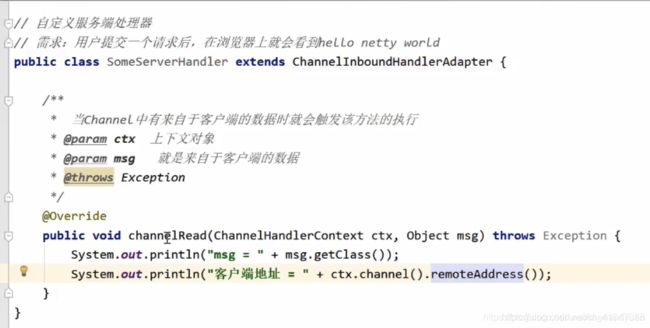
重写exceptionCaught方法,通道一但发送异常就会触发该方法:
一但发生异常我们就关闭通道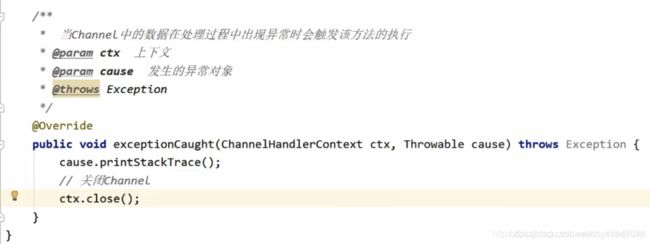
我们启动先简单测试一下:

可以看到一次请求收到消息有两种,我们需要处理的是DefaultHttpRequest
注意:
这个DefaultHttpRequest的继承体系:DefaultHttpRequest -> HttpRequest
这个HttpRequest是Netty定义的,和Servlet的HttpRequest不是一个东西,没有任何关系
注意:
使用DefaultFullHttpResponse()响应给客户端,构造如下:版本,响应状态,响应内容
HttpVersion 1.1支持长连接
响应内容需要将内容转成ByteBuf类型,可以使用Unpooled.copiedBuffer方法
创建响应对象:
// 构造response的响应体
ByteBuf body = Unpooled.copiedBuffer("hello netty world", CharsetUtil.UTF_8);
// 生成响应对象
DefaultFullHttpResponse response = new DefaultFullHttpResponse(HttpVersion.HTTP_1_1, HttpResponseStatus.OK, body);
// 获取到response的头部后进行初始化
HttpHeaders headers = response.headers();
headers.set(HttpHeaderNames.CONTENT_TYPE, "text/plain");
headers.set(HttpHeaderNames.CONTENT_LENGTH, body.readableBytes());
将响应对象放入Channel:
注意:
ctx.write只是写入到缓存,ctx.flush才会将缓存内容放入Channel
所以一般我们直接调用ctx.writeAndFlush
// 将响应对象写入到Channel
// ctx.write(response);
// ctx.flush();
ctx.writeAndFlush(response);
我们可以添加一个监听器,一但响应客户端结束,马上关闭Channel
// 将响应对象写入到Channel
// ctx.write(response);
// ctx.flush();
// ctx.writeAndFlush(response);
// ctx.channel().close();
ctx.writeAndFlush(response)
// 添加channel关闭监听器
.addListener(ChannelFutureListener.CLOSE);
public interface ChannelFutureListener extends GenericFutureListener<ChannelFuture> {
/**
* A {@link ChannelFutureListener} that closes the {@link Channel} which is
* associated with the specified {@link ChannelFuture}.
*/
ChannelFutureListener CLOSE = new ChannelFutureListener() {
@Override
public void operationComplete(ChannelFuture future) {
future.channel().close();
}
};
...
}
SpringMVC就不会出现这个问题,已经帮我们处理过了
我们可以过滤不处理/facicon.ico请求
if(msg instanceof HttpRequest) {
HttpRequest request = (HttpRequest) msg;
System.out.println("请求方式:" + request.method().name());
System.out.println("请求URI:" + request.uri());
if("/favicon.ico".equals(request.uri())) {
System.out.println("不处理/favicon.ico请求");
return;
}
可以使用匿名内部类代替ChannelInitializer,因为实例本身意义不大,就只用一次
// 用户启动ServerChannel
ServerBootstrap bootstrap = new ServerBootstrap();
bootstrap.group(parentGroup, childGroup) // 指定eventLoopGroup
.channel(NioServerSocketChannel.class) // 指定使用NIO进行通信
.childHandler(new ChannelInitializer<SocketChannel>() {
// 当Channel初始创建完毕后就会触发该方法的执行,用于初始化Channel
@Override
protected void initChannel(SocketChannel ch) throws Exception {
// 从Channel中获取pipeline
ChannelPipeline pipeline = ch.pipeline();
// 将HttpServerCodec处理器放入到pipeline的最后
// HttpServerCodec是什么?是HttpRequestDecoder与HttpResponseEncoder的复合体
// HttpRequestDecoder:http请求解码器,将Channel中的ByteBuf数据解码为HttpRequest对象
// HttpResponseEncoder:http响应编码器,将HttpResponse对象编码为将要在Channel中发送的ByteBuf数据
pipeline.addLast(new HttpServerCodec());
// 将自再定义的处理器放入到Pipeline的最后
pipeline.addLast(new SomeServerHandler());
}
}); // 指定childGroup中的eventLoop所绑定的线程所要处理的处理器
// 指定当前服务器所监听的端口号
// bind()方法的执行是异步的
// sync()方法会使bind()操作与后续的代码的执行由异步变为了同步
ChannelFuture future = bootstrap.bind(8888).sync();
自定义处理器整体代码
// 自定义服务端处理器
// 需求:用户提交一个请求后,在浏览器上就会看到hello netty world
public class SomeServerHandler extends ChannelInboundHandlerAdapter {
/**
* 当Channel中有来自于客户端的数据时就会触发该方法的执行
* @param ctx 上下文对象
* @param msg 就是来自于客户端的数据
* @throws Exception
*/
@Override
public void channelRead(ChannelHandlerContext ctx, Object msg) throws Exception {
System.out.println("-------------- " + ctx.channel());
System.out.println("msg = " + msg.getClass());
System.out.println("客户端地址 = " + ctx.channel().remoteAddress());
if(msg instanceof HttpRequest) {
HttpRequest request = (HttpRequest) msg;
System.out.println("请求方式:" + request.method().name());
System.out.println("请求URI:" + request.uri());
if("/favicon.ico".equals(request.uri())) {
System.out.println("不处理/favicon.ico请求");
return;
}
// 构造response的响应体
ByteBuf body = Unpooled.copiedBuffer("hello netty world", CharsetUtil.UTF_8);
// 生成响应对象
DefaultFullHttpResponse response = new DefaultFullHttpResponse(HttpVersion.HTTP_1_1, HttpResponseStatus.OK, body);
// 获取到response的头部后进行初始化
HttpHeaders headers = response.headers();
headers.set(HttpHeaderNames.CONTENT_TYPE, "text/plain");
headers.set(HttpHeaderNames.CONTENT_LENGTH, body.readableBytes());
// 将响应对象写入到Channel
// ctx.write(response);
// ctx.flush();
// ctx.writeAndFlush(response);
// ctx.channel().close();
ctx.writeAndFlush(response)
// 添加channel关闭监听器
.addListener(ChannelFutureListener.CLOSE);
}
}
/**
* 当Channel中的数据在处理过程中出现异常时会触发该方法的执行
* @param ctx 上下文
* @param cause 发生的异常对象
* @throws Exception
*/
@Override
public void exceptionCaught(ChannelHandlerContext ctx, Throwable cause) throws Exception {
cause.printStackTrace();
// 关闭Channel
ctx.close();
}
}
3. Demo2:Socket编程,C/S通信
前面的工程是一个仅存在服务端的 HTTP 请求的服务器,而 Netty 中最为最见的是 C/S构架的 Socket 代码。所以下面我们就来看一个 Netty 的 Socket 通信代码。
3.1 创建工程 02-socket
创建一个普通的 Maven 的 Java 工程:02-socket
本例要实现的功能是:客户端连接上服务端后,其马上会向服务端发送一个数据。服务端在接收到数据后,会马上向客户端也回复一个数据。客户端每收到服务端的一个数据后,便会再向服务端发送一个数据。而服务端每收到客户端的一个数据后,便会再向客户端发送一个数据。如此反复,无穷匮也。
3.2 定义服务端
3.2.1 定义服务端启动类
之前我们写的是Http请求响应的服务器,现在我们写到服务器和客户端之间是通过字符串通信的,所以我们添加StringDecoder和StringEncoder
// 定义服务端启动类
public class SomeServer {
public static void main(String[] args) throws InterruptedException {
EventLoopGroup parentGroup = new NioEventLoopGroup();
EventLoopGroup childGroup = new NioEventLoopGroup();
try {
ServerBootstrap bootstrap = new ServerBootstrap();
bootstrap.group(parentGroup, childGroup)
// 指定要创建Channel类型
.channel(NioServerSocketChannel.class)
.childHandler(new ChannelInitializer<SocketChannel>() {
@Override
protected void initChannel(SocketChannel ch) throws Exception {
// 获取channel中的Pipeline
ChannelPipeline pipeline = ch.pipeline();
// StringDecoder:字符串解码器,将Channel中的ByteBuf数据解码为String
pipeline.addLast(new StringDecoder());
// StringEncoder:字符串编码器,将String编码为将要发送到Channel中的ByteBuf
pipeline.addLast(new StringEncoder());
pipeline.addLast(new SomeServerHandler());
}
});
ChannelFuture future = bootstrap.bind(8888).sync();
System.out.println("服务器已启动");
future.channel().closeFuture().sync();
} finally {
parentGroup.shutdownGracefully();
childGroup.shutdownGracefully();
}
}
}
3.2.2 定义服务端处理器
ChannelInitializer中添加自定义处理器
pipeline.addLast(new SomeServerHandler());
public class SomeServerHandler extends ChannelInboundHandlerAdapter {
@Override
public void channelRead(ChannelHandlerContext ctx, Object msg) throws Exception {
System.out.println("channel = " + ctx.channel());
// 将来自于客户端的数据显示在服务端控制台
System.out.println(ctx.channel().remoteAddress() + "," + msg);
// 向客户端发送数据
ctx.channel().writeAndFlush("from server:" + UUID.randomUUID());
TimeUnit.MILLISECONDS.sleep(500);
}
@Override
public void exceptionCaught(ChannelHandlerContext ctx, Throwable cause) throws Exception {
ctx.close();
}
}
3.3 定义客户端
3.3.1 定义客户端启动类
注意:
客户端只需要一个NioEventLoopGroup
服务端要两个是因为一个专门用来处理客户端的连接请求,一个处理连接以后具体干活的请求
服务端会被很多客户端连接,需要处理很多连接请求,而客户端自己只需要处理一个连接请求
客户端使用的是BootStrap,服务端用的是ServerBootStrap
客户端使用的通道类型是NioSocketChannel
public class SomeClient {
public static void main(String[] args) throws InterruptedException {
NioEventLoopGroup group = new NioEventLoopGroup();
try {
Bootstrap bootstrap = new Bootstrap();
bootstrap.group(group)
.channel(NioSocketChannel.class)
.handler(new ChannelInitializer<SocketChannel>() {
@Override
protected void initChannel(SocketChannel ch) throws Exception {
ChannelPipeline pipeline = ch.pipeline();
pipeline.addLast(new StringDecoder());
pipeline.addLast(new StringEncoder());
pipeline.addLast(new SomeClientHandler());
}
});
ChannelFuture future = bootstrap.connect("localhost", 8888).sync();
future.channel().closeFuture().sync();
} finally {
group.shutdownGracefully();
}
}
}
3.3.2 定义客户端处理器
public class SomeClientHandler extends SimpleChannelInboundHandler<String> {
// msg的消息类型与类中的泛型类型是一致的
@Override
protected void channelRead0(ChannelHandlerContext ctx, String msg) throws Exception {
System.out.println(ctx.channel().remoteAddress() + "," + msg);
ctx.channel().writeAndFlush("from client:" + LocalDateTime.now());
TimeUnit.MILLISECONDS.sleep(500);
}
@Override
public void exceptionCaught(ChannelHandlerContext ctx, Throwable cause) throws Exception {
ctx.close();
}
}
客户端和服务端都需要等待对方发送消息后才会回复,所以需要有一个人先发送消息,我们让客户端在连接成功时先发送消息
channelActive()方法:当Channel被激活后会触发该方法的执行
public class SomeClientHandler extends SimpleChannelInboundHandler<String> {
...
// 当Channel被激活后会触发该方法的执行
@Override
public void channelActive(ChannelHandlerContext ctx) throws Exception {
ctx.channel().writeAndFlush("from client:begin talking");
}
}
3.4 SimpleChannelInboundHandler和ChannelInboundHandlerAdapter的区别
首先SimpleChannelInboundHandler是继承ChannelInboundHandlerAdapter的。
当管道有数据时,会触发ChannelInboundHandlerAdapter.channelRead()方法
public abstract class SimpleChannelInboundHandler<I> extends ChannelInboundHandlerAdapter {
...
@Override
public void channelRead(ChannelHandlerContext ctx, Object msg) throws Exception {
boolean release = true;
try {
if (acceptInboundMessage(msg)) {
@SuppressWarnings("unchecked")
I imsg = (I) msg;
channelRead0(ctx, imsg);
} else {
release = false;
ctx.fireChannelRead(msg);
}
} finally {
if (autoRelease && release) {
//区别就在这!!!
ReferenceCountUtil.release(msg);
}
}
}
...
}
SimpleChannelInboundHandler中的channelRead()方法会自动释放接收到的来自于对方的msg所占有的所有资源。
ChannelInboundHandlerAdapter 中的 channelRead()方法不会自动释放接收到的来自于对方的msg
若对方没有向自己发送数据,则自定义处理器建议继承自ChannelInboundHandlerAdapter。因为若继承自 SimpleChannelInboundHandler 则必须重写channelRead0()方法。而重写该方法的目的是对来自于对方的数据进行处理。因为对方根本就没有发送数据,所以也就没有必要重写 channelRead0()方法。
若对方向自己发送了数据,而自己又需要将该数据再发送给对方,则自定义处理器建议继承自ChannelInboundHandlerAdapter。因为 write()方法的执行是异步的,且SimpleChannelInboundHandler 中的 channelRead()方法会自动释放掉来自于对方的 msg。若 write()方法中正在处理 msg,而此时 SimpleChannelInboundHandler 中的 channelRead()方法执行完毕了,将 msg 给释放了。此时就会报错。

PS:关于这个释放正常启动一般也没什么问题,我们看一下释放的代码:
//io.netty.util.ReferenceCountUtil#release(java.lang.Object)
public static boolean release(Object msg) {
//只有消息被封装成了ReferenceCounted,才需要释放
//而据我了解,只有通过Netty配置,开启了一种“Debug”模式,才会将消息封装成这个对象
//所以一般不会用,后期源码分析会看到
if (msg instanceof ReferenceCounted) {
return ((ReferenceCounted) msg).release();
}
return false;
}



